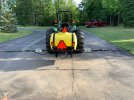The amount of glyphosate you use should come from the label an your specific application. In general, when folks are talking about 2 qt/ac, that referencing the typical 41% glyphosate label. You don't use oz/gal for ag/food plot applications. You need to calibrate your sprayer. You need enough water to get even coverage of the product. The key is the amount of product per area, not how much product per gal or how many gal of water you use.
The 2 qt/ac assumes the common concentration of 41%.
There are several methods to calibrate your sprayer. I use the 1/128 acre method. You can find formulas on line for it. Basically, you fill your sprayer with water and fix the pressure setting then measure a distance specified by the formula and drive it timing yourself with a stop watch. You then stop the tractor and keep the pump going at the same rate and collect water for that time period your measured from one nozzle of your sprayer. You plug that time back into the formula and it will give you how much fluid your sprayer puts out per acre.
Once you know this, you are calibrated. If you are going to spray one acre you put in that much water and 2 quart of 41% gly (if that is appropriate for your application). If you are gong to spray 2 acres, you double the water and double the gly. You now have the ratio of gly to water that works for your sprayer.
41% gly has about 80% of the gly that is in 50% gly, so instead of using 2 qt/ac of 50% you would use about 1.6 quarts/ac.
Thakns,
Jack


